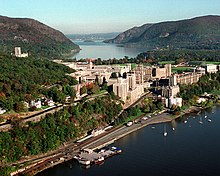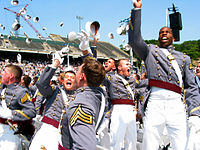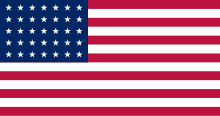User:Ahodges7/Sandbox
| Home | Talk | Awards | Contributions | Images | Sandbox | To do |
Disputed image (removed)

Test fire on user award

|
Honorary Maverick | |
| As former commander, "Maverick06", of Bravo Troop, 1st Squadron, 6th US Cavalry, and Maverick Emeritus, I hereby bestow upon you the Order of the Honorary Maverick for your ... |
More testdrives on signature
Ahodges7 talk 12:36, 7 February 2009 (UTC) Ahodges7 talk 12:38, 7 February 2009 (UTC)
Grounds and facilities list

The academy is located approximately 50 miles (80 km) north of New York City on the western bank of the Hudson River. Based on the significance both of the Revolutionary War fort ruins and of the military academy itself, the majority of the academy area was declared a National Historic Landmark in 1960.[1][2] In 1841, Charles Dickens visited the academy and said "It could not stand on more appropriate ground, and any ground more beautiful can hardly be."[3] Though the entire military reservation encompasses15,974 acres (65 km2), the academic area of the campus, known as "central area" or "the cadet area", is entirely accessible to cadets or visitors by foot.[4] In 1902, the Boston architectural firm Cram, Goodhue, and Ferguson was awarded a major construction contract that set the predominantly neogothicarchitectural style still seen today.[5] The academy grounds are home to numerous monuments and statues. The central cadet parade ground,the Plain, hosts the largest number, and includes the Washington Monument, Thayer Monument, Eisenhower Monument, MacArthur Monument,Kosciuszko Monument, and Sedgwick Monument. A monument to George S. Patton was dedicated in front of the cadet library in 1950,[6] but in 2004 it was placed in storage to make room for the construction of Jefferson Hall and has yet to be relocated. There is also a statue commemorating brotherhood and friendship from the L'Ecole Polytechnique in the cadet central area just outside Nininger Hall. The remaining campus area is home to 27 other monuments and memorials.[7]
The West Point Cemetery is the final resting place of many notable graduates and faculty, including George Armstrong Custer, William Westmoreland, Earl Blaik, Maggie Dixon, and sixteen Medal of Honor recipients.[8][9] The cemetery is also the burial place of several recent graduates who have died during the ongoing Global War on Terror. Many of the older grave sites have large and ornate grave markers, the largest belonging to Egbert Viele (class of 1847), chief engineer of Brooklyn's Prospect Park.[8] The cemetery is also home to a monument toRevolutionary War heroine Margaret Corbin.[10]
West Point is home to historic athletic facilities like Michie Stadium and Gillis Field House as well as modern facilities such as the Licthenburg Tennis Center, Anderson Rugby Complex, and the Lou Gross Gymnastics Facility.[11] Michie Stadium recently underwent a significant upgrade in facilities for the football team, and the academy installed a new artificial turf field in the summer of 2008.[12]
The visitor's center is just outside the Thayer Gate in the village of Highland Falls and offers the opportunity to arrange for a guided tour. These tours, which are the only way the general public can access the academy grounds, leave the visitor's center several times a day. The West Point Museum is directly adjacent to the visitor's center, in the renovated Olmsted Hall on the grounds of the former Ladycliff College. Originally opened to the public in 1854, the West Point Museum is the oldest military museum in the country.[13][14] During the summer months, the museum operates access to the Fort Putnam historic site on main post.[15]
| Building | Image | Constructed | Description | Reference |
|---|---|---|---|---|
| West Point Cadet Chapel (Protestant) | 1910 | Constructed in 1910 to replace the original Cadet Chapel built in 1836, the main Cadet Chapel conducts protestant services and dominates the backdrop of the Plain. | [16] | |
| Catholic Chapel | 
|
1899 | On the corner of Stoney Lonesome and Washington roads, the picturesque chapel was constructed in 1900, and expanded and re-dedicated in 1933. | [17] |
| Jewish Chapel | 1984 | Built in 1984 on Merritt Road, this chapel was the culmination of 20 years of effort of the private West Point Jewish Chapel Fund. | [18] | |
| Old Cadet Chapel | 1836 | Originally completed in the cadet central area in 1836, graduates paid for the deconstruction and movement of the building in 1911 to the West Point cemetery upon completion of the current Cadet Chapel. The building remains in use and is frequently the site of funerals and memorial services. | [19] |
| Building | Image | Constructed | Description | Reference |
|---|---|---|---|---|
| Pershing Barracks | 1895 | First constructed in 1895 as the East Academic Building, it was remodeled and converted to barracks in 1952. It was originally designed by architect XXX as part of a large expansion of the academy facilities between 1895 and 1910. | [20] |
| Building | Image | Constructed | Description | Reference |
|---|---|---|---|---|
| Quarters #100, (Superintendent) | 1820 | Built during the tenure of Sylvanus Thayer, the "Supe's" quarters is the second oldest residence on post, with only the Commandant's quarters being older. A mixture of Georgian and Federal architecture, it is both a private residence and a public landmark. Tours are available during certain times of the year. | [21] | |
| Quarters #101, (Commandant) | 1818 | The oldest quarters on post, built two years before the Superintendent's quarters, this three story georgian colonial is home to the Commandant of Cadets. |
References
- ^ "United States Military Academy". National Historic Landmarks Program. Retrieved 2009-01-04.
- ^ "National Register of Historic Places Inventory-Nomination: United States Military Academy" (PDF). National Park Service. Retrieved 2009-01-04.
- ^ Simpson (1982), p. 13.
- ^ Cite error: The named reference
sizewas invoked but never defined (see the help page). - ^ Palka (2008), p. 27.
- ^ Palka (2008), p. 179.
- ^ Miller (2002), pp. 128–130.
- ^ a b Poughkeepsie (2003), p. 16.
- ^ "West Point Cemetery". USMA Office of the Dean. Retrieved 2009-01-04.
- ^ "Corbin". USMA Department of History. Retrieved 2009-01-14.
- ^ "Blaik Field at Michie Stadium". GoArmySports.com. Retrieved 2009-01-13.
- ^ "FieldTurf is the Choice for Army's Legendary Michie Stadium". Reuters. Retrieved 2009-01-13.
- ^ Poughkeepsie (2003), p. 7.
- ^ "The West Point Museum". United States Military Academy. Retrieved 2009-02-03.
- ^ ""Fort Putnam"". United States Military Academy. Retrieved 2009-01-18.
- ^ "Cadet Chapel". USMA.edu. Retrieved 2009-3-23.
{{cite web}}: Check date values in:|accessdate=(help) - ^ "Catholic Chapel". USMA.edu. Retrieved 2009-3-23.
{{cite web}}: Check date values in:|accessdate=(help) - ^ "Jewish Chapel". USMA.edu. Retrieved 2009-3-23.
{{cite web}}: Check date values in:|accessdate=(help) - ^ "Old Cadet Chapel". USMA.edu. Retrieved 2009-3-23.
{{cite web}}: Check date values in:|accessdate=(help) - ^ "Timeline of History: 1850-1899". USMA.edu. Retrieved 2009-3-25.
{{cite web}}: Check date values in:|accessdate=(help) - ^ "Timeline of History: 1850-1899". USMA.edu. Retrieved 2009-3-25.
{{cite web}}: Check date values in:|accessdate=(help)
|
This is a test box! I did it, woo hoo!
|
Supe sandbox
| This user page or section is in a state of significant expansion or restructuring. You are welcome to assist in its construction by editing it as well. If this user page has not been edited in several days, please remove this template. If you are the editor who added this template and you are actively editing, please be sure to replace this template with {{in use}} during the active editing session. Click on the link for template parameters to use.
This page was last edited by Εὐθυμένης (talk | contribs) 3 years ago. (Update timer) |
Wikibreak header


The United States Military Academy (USMA) is an undergraduate college in West Point, New York that educates and commissions officers for the United States Army during the American Civil War. The Academy was founded in 1802 and graduated its first class in October of the same year. It is the oldest of the five American service academies. Sports media refer to the Academy as "Army" and the students as "Cadets"; this usage is officially endorsed.[1] A small number of graduates each year choose the option of entering the United States Air Force, United States Navy, or United States Marine Corps. Before the founding of the United States Air Force Academy in 1955, the Academy was a major source of officers for the Air Force and its predecessors. Most cadets are admitted through the congressional appointment system.[2][3] The curriculum emphasizes various fields in sciences and engineering.[4][5]
This list is drawn from alumni of the Military Academy who served as general officers in the Union Army (US Army). This includesWilliam Tecumseh Sherman (class of 1840), Abner Doubleday (class of 1842), Ulysses S. Grant (class of 1843), George Crook(class of 1852), Philip Sheridan (class of 1853). This also includes six recipients of the Medal of Honor: Rufus Saxton (class of 1849), Eugene Asa Carr (class of 1850), John Schofield (class of 1853), Oliver O. Howard (class of 1854), Alexander S. Webb (class of 1855), and Adelbert Ames (class of 1861).[a]
Other notable graduates include 2 Presidents of the United States, 18 astronauts, 4 heads of state, 74 Medal of Honor recipients,[6] 70 Rhodes Scholars, and 3 Heisman Trophy winners.[7] Among American universities, the Academy is fourth on the list of total winners for Rhodes Scholarships, seventh forMarshall Scholarships and fourth for Hertz Fellowships.[8]
Union Army officers
- Note: "Class year" refers to the alumni's class year, which usually is the same year they graduated. However, in times of war, classes often graduate early.
- 'ex' after the class year indicates the alumni is a non-graduating member of that class.
————— MY USER PAGE —————
| Home | Talk | Awards | Contributions | Images | Sandbox | To do |
|
- ^ "Quick Facts". United States Military Academy (USMA). Retrieved 2009-03-04.
- ^ "FAQ: Who Attends the US Military Academy?". USMA Office of Admissions. Retrieved 2009-03-21.
- ^ "Overview of the Academy". USMA Office of Admissions. Retrieved 2009-03-21.
- ^ "College Navigator – United States Military Academy". National Center for Education Statistics, United States Department of Education. Retrieved 2009-03-21.
- ^ "Academic Catalog: "The Redbook"". USMA Office of the Dean. 2008-09-10. Retrieved 2008-03-21.
- ^ "Medal of Honor Citations". Army Center of Military History. Retrieved 2010-01-27.
- ^ "Notable USMA Graduates". USMA. Retrieved 2009-03-21.
- ^ "Scholarship Winners". USMA Office of the Dean. Retrieved 2008-12-19.




